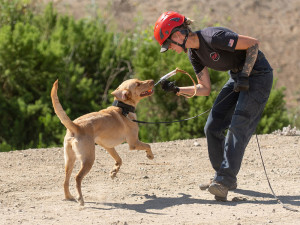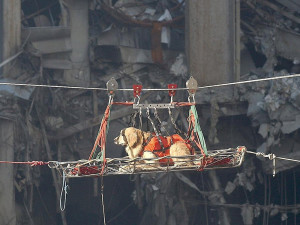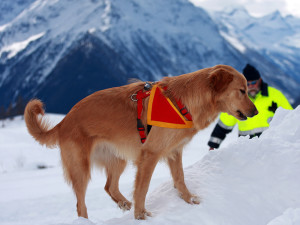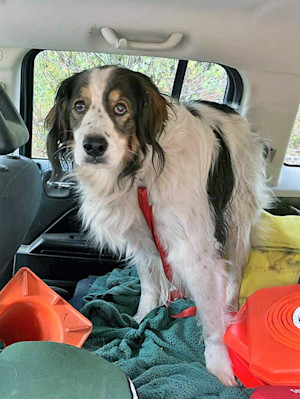What Is a Cadaver Dog? All Your Questions, Answered
A viral TikTok story got us all interested in these working pups, so we asked an expert for answers.

Share Article
Last week, the internet obsessively waited for the answer to one morbid question: Did TikToker Katie Santry find a dead body in her backyard? Two cadaver dogs initially signaled potential human remains when police investigated the site, but police confirmed Friday that there is no dead body on the premises. Now, online spectators have moved on to a new, only slightly less macabre question: How do cadaver dogs work, anyway?
Long story short, Santry, who lives in Columbus, Ohio, was digging holes while preparing to install a fence behind her home when she discovered what seemed like a mysterious rug buried under just a few feet of dirt. Santry posted dozens of videos as the incident unfolded, accumulating millions upon millions of views in the process.
With each update, the TikToker (and her audience) became more and more suspicious that there was a body buried in her backyard, especially after the dogs seemed to signal as much. In the end, however, police found no human remains. Speaking with the Columbus Dispatchopens in new tab, a Columbus Division of Police spokeswoman said authorities found “some remnants of a rug.”
This is good news for Santry, who’d begun to wonder if her home was haunted after she woke up one morning to find her laptop broken and some items misplaced. But now, she’s left asking what the rest of TikTok wants to know: If there was no dead body, why did the cadaver dogs signal in the first place?

We spoke with Jason Purgason, president of Highland Canine Training, LLCopens in new tab, to answer all of your suddenly burning questions about cadaver dogs, their jobs, and the training they receive.
OK, let’s get this out of the way: Can cadaver dogs be wrong?
Of course. Like all of us, cadaver dogs sometimes get it wrong. According to Purgason, a cadaver dog’s accuracy rate will depend on a number of factors including how it was trained, how it’s maintained and handled, and its baseline aptitude for that kind of work. As with any profession, some cadaver dogs are better than others.
“The handlers of those dogs will often tell you, they're never wrong, but the reality is that [sometimes] they are,” Purgason says. “...I’ve seen some that are wrong more than they're right, to be honest.”
That’s why Purgason says that it’s crucial for anyone training and handling cadaver dogs to meet the industry standard by obtaining and maintaining third-party certification from a government agency, a nonprofit, or an organization like Highland Canine Training. Although these evaluations are optional, they help ensure that dogs working in the field are as effective as possible.
Now that we got that out of the way, let’s go to basics. What is a cadaver dog?
Cadaver dogs are trained to find deceased or decomposing humans. “Not to be graphic,” Purgason says, “but they will find the slightest blood droplets all the way up to entire decomposed bodies.”
Are cadaver dogs different from search-and-rescue dogs?
Search-and-rescue dogs look for people who are still alive, while cadaver dogs search for human remains. Both search and rescue dogs and cadaver dogs will likely be trained under a certain specialization.
Search-and-rescue dogs include urban search-and-rescue dogs (also known as disaster dogs), who are trained to navigate piles of rubble in search of survivors. Scent-discrimination-trailing dogs search for lost or missing people, like lost campers, children, and dementia patients. Wilderness dogs are trained to find live people in large, open wilderness areas.
Cadaver dogs also fall into a few different categories as well. Land-cadaver dogs search areas including open fields, shallow graves, homes, and abandoned buildings. Disaster-cadaver dogs search natural and manmade disaster sites for human remains, and water-cadaver dogs are specially trained to search aquatic environments.
How often are cadaver dogs used?
This can depend on the situation and the area, but generally, Purgason says that cadaver and search-and-rescue dogs work far less than bomb dogs and drug dogs for one fascinating reason: In the U.S., most of the cadaver dogs are trained and handled by civilian volunteers — not by law enforcement or the government.
“So, as you can imagine, there’s a substantial amount of coordination that has to take place,” Purgason says. “These volunteers are working 8-to-5 jobs, you know? Are they available? Is their dog healthy enough to work? There’s just a lot that goes into it.”
Do all cadaver dogs use the same signals?
Like, do all cadaver dogs sit down to signal potential human remains? Well, no. According to Purgason, cadaver dog signals are not standardized. Highland Canine Training, for instance, uses a “freeze-and-lock” signal to indicate potential human remains — not a sit.
What are “potential human remains”? What sorts of other discoveries can these dogs make?
Apart from an entire human body, Purgason says that “potential human remains” could cover a wide spectrum of things. “It could just be teeth, it could be bone, it could be hair, it could be blood. It could be any part of the body, depending on how the dogs or how well it's imprinted and trained.”
And when we say things like hair or blood, Purgason confirms that we could be talking about very small amounts — think droplets of blood.
What signals do cadaver dogs learn?
According to Purgason, this is where best practice and actual practice can sometimes differ. From his perspective, cadaver dogs should be trained only to locate decomposing human remains — not live humans, and not live or deceased animals. The more inputs these dogs are taught to look for, Purgason says, the higher the risk that they’ll deliver false signals.
That said, some well-intentioned trainers will train dogs to find people who are alive as well as deceased. Those dogs are called “dual-trained” or “cross-trained.” The problem is that if you have a lot of people examining a site or even using hand tools to dig, they’re going to deposit human odor, which can compromise the reliability of a cross-trained dog’s signals. Although these dogs are trained to use different signals for live versus deceased human flesh, those wires tend to get crossed in the field — a lesson, Purgason says, that we especially learned during 9/11 rescue efforts.
Some handlers also train their dogs using animal parts — especially pigs, which have historically been used in anthropological research because of the biological similarities between pigs and human beings. In this setting, however, “That’s not helpful,” Purgason says. It can create even more confusion.

Laura Bradley
Laura is a New York-based experienced writer and mom of two rescue pups. Her work has appeared in Slate, Vanity Fair, Daily Beast, The Washington Post, The Atlantic, Yahoo! News, Vulture, Grazia Magazine, and more. When she is not writing or walking the pooches, you will probably find her in the community garden.
Related articles
![SAR dog works with a trainer on search and rescue training]()
Once Surrendered Shelter Pups Save Lives as Search-and-Rescue Dogs
Learn how the National Disaster Search Dog Foundation trains abandoned shelter pups to become SAR dogs.
![Riley the rescue Golden Retriever being transported out of the debris of the World Trade Center.]()
Honoring the Heroic Rescue Dogs of 9/11
We pay tribute to the pups who risked their lives to save others 24 years ago.
Does Your Dog Have Therapy Dog Potential?
Renowned animal behaviorist Patricia McConnell, PhD, on what it takes to be a great therapy dog.
![Rescue dog standing in the snow with the mountains and an emergency medic in the background]()
Paw Patrol: How Avalanche Rescue Dogs Make the Slopes Safer for Everyone
Meet the pups who are saving lives, one rescue at a time.
![A dog turned into a hero when she led a deputy to her injured 84-year-old owner in Washington.]()
A 13-Year-Old Rescue Dog Saves Her Injured 84-Year-Old Guardian by Leading Police to His Home
“We credit Gita for saving his life that day,” the Sheriff’s Office said.
![Man in military uniform with German shepherd dog outdoors.]()
This Organization Helps Veteran Dogs Find Loving Homes After Serving Our Country
This Veteran’s Day, show your support for Mission K9 Rescue.







